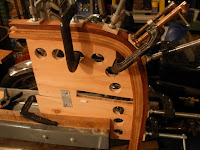
After the first run of planking dried, I tried my hand at planing it down. First of all, having the molds only loosely clamped in place didn't help things-- It was moving all over the place! I also learned the importance of machining the planks for edge grain. The boards with face grain were tearing out like crazy!
The final lesson of the day was that I can only do about four planks at a time. Towards the top of the run, I wasn't getting enough clamping pressure and the boards didn't seat completely. You don't see it at first, but when you start to plane past the edges of the cove, big gaps start to appear.
All in all, I'm not upset. I fully expected things to go wrong. The whole point of this exercise was to find out what would fail and how we could improve on it later.










